Datebook: The minimalism of Tony DeLap, ceramics by Dora De Larios and the internet according to Petra Cortright
A key Southern California minimalist and an important Los Angeles ceramicist get museum reappraisals. Plus, shows of painting, video and sculpture. Here are nine exhibitions and events to check out in the coming week:
“Tony DeLap: A Retrospective,” at the Laguna Art Museum. The museum has put together a retrospective dedicated to the Southern California finish fetish artist who has explored color, form and minimalism in a career that has spanned more than six decades. The show will feature an estimated 80 paintings, sculptures and drawings — and an accompanying catalog will track his career. Opens Sunday, 307 Cliff Drive, Laguna Beach, lagunaartmuseum.org.
Dora De Larios, “Other Worlds,” at the Main Museum. Over a long-running career, the Los Angeles-born ceramic artist created work that fused the modern with the Mexican and the Japanese. Now the downtown museum is inaugurating a new gallery space with a survey of the late artist’s work — De Larios died last month — bringing together whimsical sculpture, graceful dishware and the elegant plates she crafted especially for a White House lunch. Opens Sunday and runs through May 13. 114 W. 4th St., downtown Los Angeles, themainmuseum.org.
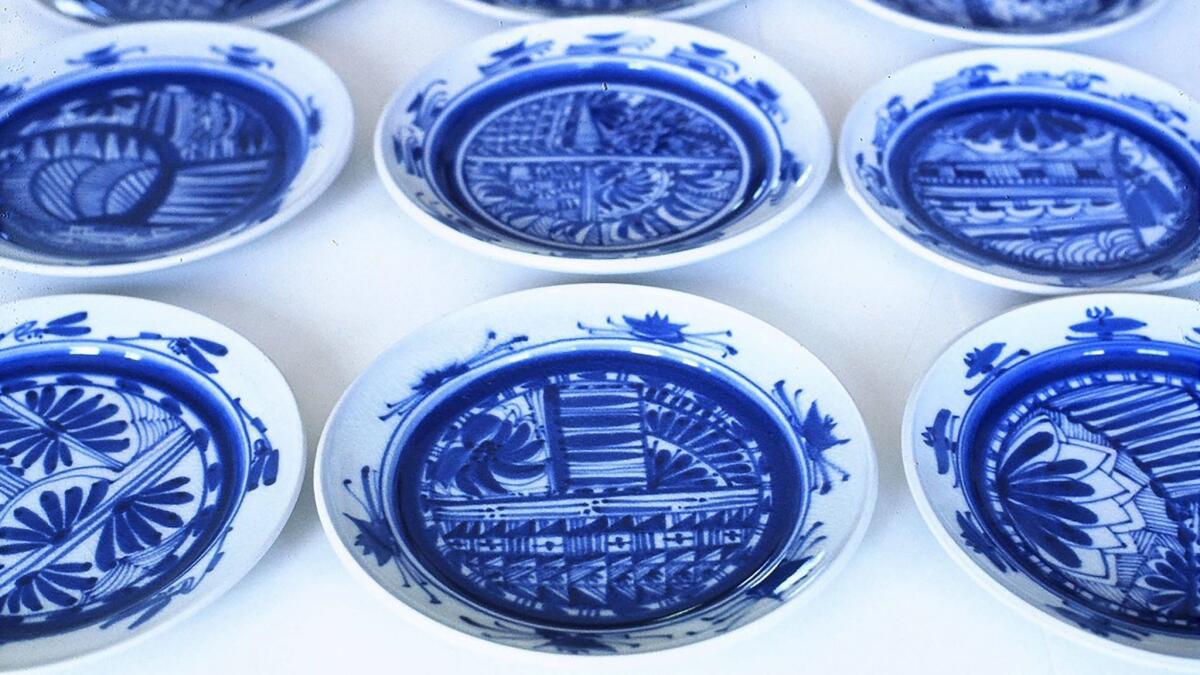
Rigo 23, “Ripples Become Waves,” at the Main Museum. Also opening at the museum this week is a show by the L.A.-based artist Rigo 23, highlighting the case of Leonard Peltier, a member of the American Indian Movement who received a life sentence in connection with the shooting deaths of two FBI agents in 1975. On view will be the sculpture of Peltier that the artist made for American University’s campus in 2017, a work that was subsequently (and controversially) removed. Opens Sunday and runs through May 13. 114 W. 4th St., downtown Los Angeles, themainmuseum.org.
Petra Cortright, “CAM WORLD,” at UTA Artist Space. The gallery has put together a large-scale survey of the L.A.-based artist’s video work that draws from the culture of surveillance and the internet. This includes works that dwell on the artist’s own online presence and the ways in which the female body is rendered online. Opens Saturday at 5 p.m. 670 S. Anderson St., Boyle Heights, Los Angeles, utaartistspace.com.
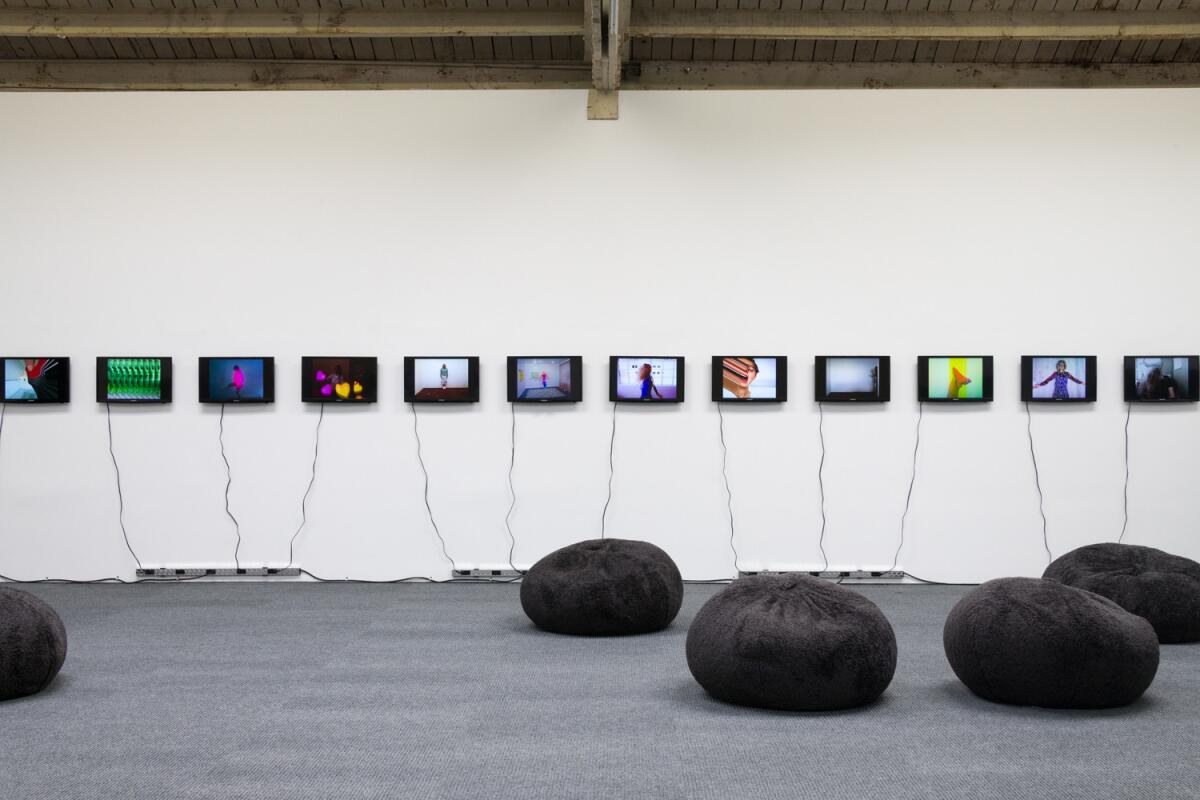
Pontus Willfors, “Shop,” at Denk. The sculptor is known for his creative takes on mundane objects: cars and shopping carts crafted from wood, furnishings rendering in surreal ways, wood sculptures that are sculptures but also bits of tree. At Denk, he will present a series of new works. Opens Saturday at 6 p.m. and runs through April 7. 749 E. Temple St., downtown Los Angeles, denkgallery.com.
“The Daily Gentrifier: West Coast Edition,” hosted by Public School Los Angeles. For those who need to explore that connection between art and gentrification a little more heartily, look no further than Dushko Petrovich’s hyper-local publication the Daily Gentrifier. (Sample headline: “New Mariachi Plaza Will Have Everything but Mariachis.”) Petrovich, who is based in Chicago, is now in town to lead a reading of the West Coast edition of his deadly sardonic and dead-serious publication. Friday at 7 p.m. 951 Chung King Road, Chinatown, Los Angeles, facebook.com.
Herakut, “Herakut’s Rental Asylum,” at Corey Helford Gallery. The street art duo known as Herakut — Jasmin Siddiqui and Falk Lehmann — are known for the bold figurative murals they have placed in cities all over the world. This show gathers their work on canvas, combining photo-realist tendencies and the drips of street painting. Opens Saturday at 7 p.m. and runs through March 31. 571 S. Anderson St., Boyle Heights, Los Angeles, coreyhelfordgallery.com.

Sheridan Lowrey, “Bulky Item/Curb Alert,” at Cornelius Projects. The artist records the myriad castoffs that appear on San Pedro streets — bit of private lives that end up in public space. Opens Saturday at 6 p.m. and runs through March 31. 1417 S. Pacific Ave., San Pedro, corneliusprojects.com.
Gilbert “Magu” Luján, “Recuerdos del Futuro: Roaming Magu’s Chicano Dreams,” at La Plaza de Cultura y Artes. This show on the late artist, a founding member of the influential collective Los Four, gathers 81 works — including paintings, drawings and sculpture — that tracks the ways in which he employed quotidian imagery to channel a Chicano futurist vibe. Embedded in his paintings and surreal installations were images of graffiti, lowriders, dogs and elements of the rasquache (or lowbrow). As part of the show, two contemporary artists — the calligraphy artist JERK and printmaker Daniel Gonzalez — were invited to create work in dialogue with Magu. Through June 25. 501 N. Main St., downtown Los Angeles, lapca.org.

LAST CHANCE
Galeria Perdida, “Grief Will Be My Mirror,” at Mandujano Cell. The Mexican collective has created a sculptural installation that draws a connection between Goth subculture and the poet and filmmaker Piero Paolo Pasolini. Expect the thoughtfully weird. Through Saturday. 171 N. La Brea Ave., Inglewood, mandujano-cell.com.
“Día de los Muertos: A Cultural Legacy, Past, Present & Future,” at Self Help Graphics & Art. A historic exhibition looks back at the celebrations for Day of the Dead organized by the community arts nonprofit since 1972. This includes photography, historical prints and three specially commissioned altars from Ofelia Esparza, Marcus Kuiland-Nazario and Gerardo Yépiz (otherwise known as Acamonchi). Through Saturday. 1300 E. 1st St., Boyle Heights, Los Angeles, selfhelpgraphics.com.
“Future Feminine,” at Fahey/Klein. A group exhibition brings together a distinctly female gaze to the lens: a group of young female photographers exploring, gender, identity, sexuality and other themes in their work. Through Saturday. 148 N. La Brea, Hancock Park, Los Angeles, faheykleingallery.com.
Judith Linhares, “The Way She Goes to Town,” at Various Small Fires. The Los Angeles artist is known for her paintings of “unabashed” women — featuring buoyant figures working, dancing and in repose, all rendered in broad brushstrokes and acid colors. Through Saturday. 812 N. Highland Ave., Hollywood, vsf.la.
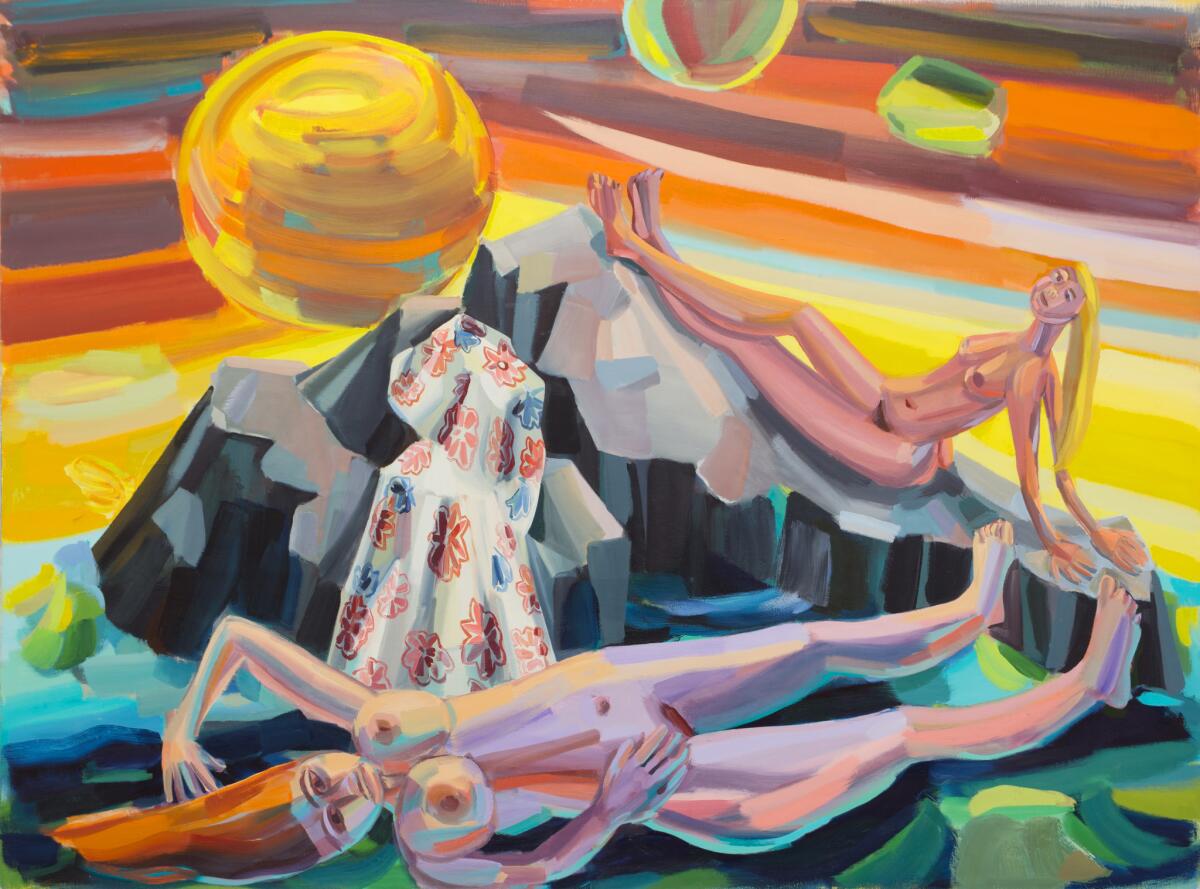
Robb Putnam, “Interlopers,” at Walter Maciel Gallery. Putnam takes materials such as old parachutes, drop cloths, Army blankets and duffel bags and uses them to create an artistic collection of bear-like creatures that he suspends on the gallery walls. Through Saturday. 2642 S. La Cienega Blvd., Culver City, waltermacielgallery.com.
Ken Gonzales-Day, “Surface Tension: Murals, Signs, and Mark-Making in L.A.,” at the Skirball Cultural Center. Gonzalez-Day is a conceptual photographer known for projects that have chronicled old hanging trees, reimagined scenes of protest and historical happenings connected with his roots. For this PST: LA/LA exhibition, he turns his attention to murals and the ways in which they inhabit L.A.’s urban landscape. Through Sunday. 2701 N. Sepulveda Blvd., Brentwood, skirball.org.
“Transpacific Borderlands: The Art of Japanese Diaspora in Lima, Los Angeles, Mexico City and Sao Paulo,” at the Japanese American National Museum. This exhibition also examines the intricate nature of Latin American identity — which, in many nations, bears a distinctly Japanese stamp. Expect work by artists of Japanese heritage working throughout the continent, whose art explores issues of homeland, race and cosmopolitanism. Through Sunday. 100 N. Central Ave., Los Angeles, janm.org.
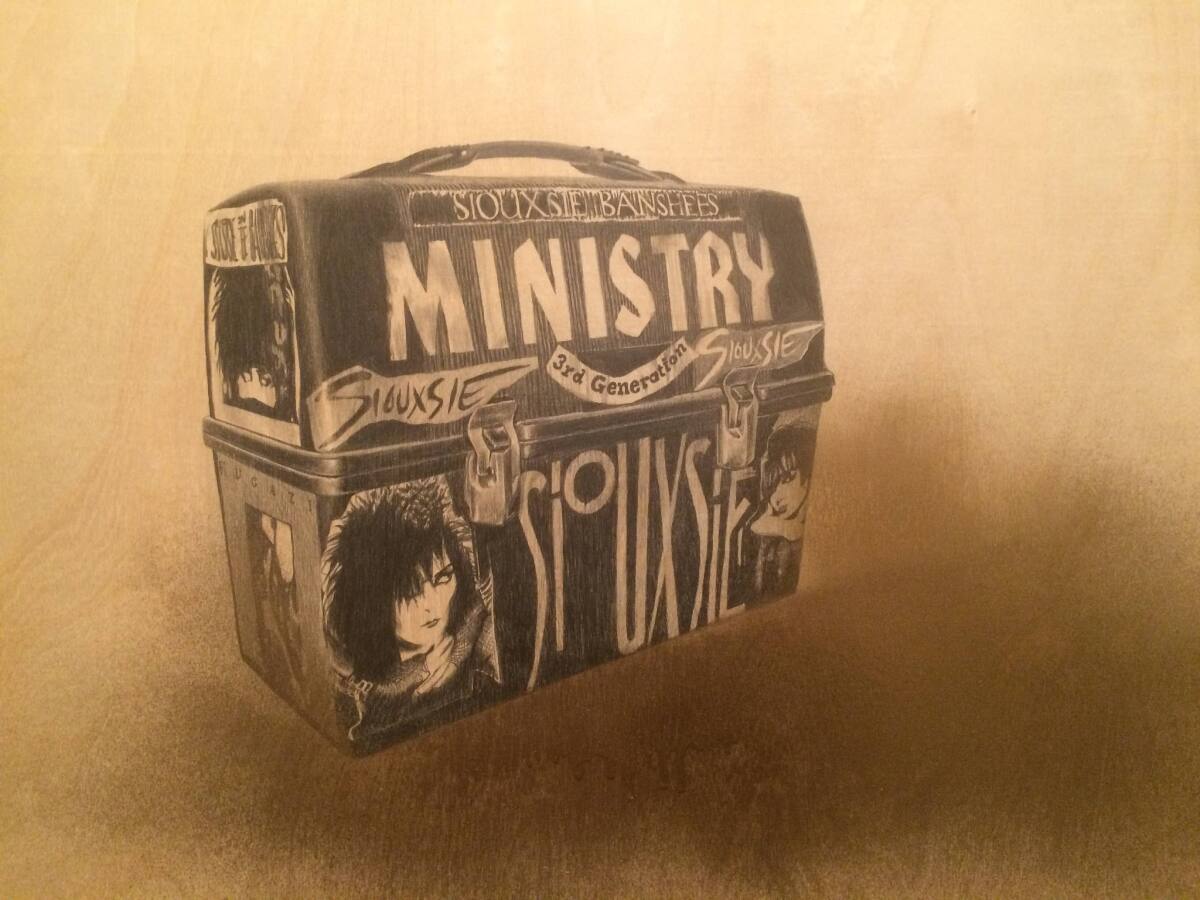
“Another Promised Land: Anita Brenner’s Mexico,” at the Skirball Cultural Center. Brenner was an American Jewish writer who was associated with an important cohort of 1920s Mexican modernists and was key to presenting Mexican art to audiences in the United States. She was close with figures such as José Clemente Orozco, Frida Kahlo, Diego Rivera and Tina Modotti — and some of their art is featured in the show, along with Brenner’s personal effects. Through Sunday. 2701 N. Sepulveda Blvd., Brentwood, Los Angeles, skirball.org.
“Circles and Circuits: Chinese Caribbean Art,” at the Chinese American Museum and the California African American Museum. Latin American identity is often identified with the concept of the mestizo, the hybrid indigenous-Spanish culture that has predominated in large parts of Latin America. But the Asian contribution has been key to the development of culture, food and industry. This two-part exhibition looks at the Chinese presence in countries on the Caribbean Sea, including Jamaica, Cuba, Panama and Trinidad and Tobago. On view at CAAM through Sunday. 600 State Dr., Exposition Park, Los Angeles, caamuseum.org. The second part of the show at the Chinese American Museum is on view for two more weeks through March 11. 425 N. Los Angeles St., downtown Los Angeles, camla.org.

Hugo Crosthwaite, “In Memoriam Los Angeles,” at the Los Angeles Methodist Museum of Social Justice. The noted Tijuana painter, known for phantasmagoric black and white murals that seamlessly fuse slices of urban life with the fantastical, created an improvisational mural — painted during opening hours — that was inspired by his observations of people in downtown Los Angeles. Over the course of February, Crosthwaite has been obliterating the piece bit by bit. Through Feb. 25. La Plaza United Methodist Church, 115 Paseo de la Plaza, Los Angeles, museumofsocialjustice.org.
“The Reformation: From the Word to the World,” at the Huntington. It is the 500th anniversary of the Protestant Reformation and this is the second Los Angeles exhibition to explore the legacy of that momentous religious and social shift. (The first was at the Los Angeles County Museum of Art last year.) Drawn primarily from the holdings of the Huntington’s collections, it features 50 rare books and manuscripts, as well as prints made between the 1400s and 1648 (the end of the Thirty Years War). Expect to see treasures by Albrecht Dürer as well as a real-deal papal indulgence signed by Pope Leo X in 1515 — a.k.a. the sorts of things you learned about in school. Through Feb. 26. 1151 Oxford Road, San Marino, huntington.org.
ONGOING
“To Protect & Serve: Posters Protesting 50 Years of Police Violence,” by the Center for the Study of Political Graphics” at the Durón Gallery at SPARC. A bilingual exhibition organized by the Center for the Study of Political Graphics brings together 75 posters that deal with the issue of police violence in cities across the U.S., as well as in Mexico, Chile, Europe and Africa. Through March 2. 685 Venice Blvd., sparcinla.org and politicalgraphics.org.
William Powhida, “After ‘After the Contemporary,’” at Charlie James Gallery. For a recent exhibition at the Aldrich Museum in Connecticut, the New York-based artist created a fictional look back at our current moment — which he dubbed “the Contemporary” — from the perspective of the year 2050. For this exhibition, he presents 120 fictional Artforum ads that purportedly record the major artistic happenings of the so-called Contemporary. Expect to see selfie experiences such as the Museum of Ice Cream and mega galleries such as Hauser & Wirth gleefully eviscerated. Through March 3. 969 Chung King Rd. Chinatown, Los Angeles, cjamesgallery.com.
Mira Dancy, “High Hell,” at Night Gallery. In her third solo exhibition at the gallery, the New York painter presents a series of brightly hued, expressionistic works that depict a female figure in the midst of wild, at times disintegrating, landscapes. Through March 3. 2276 E. 16th St., downtown Los Angeles, nightgallery.ca.
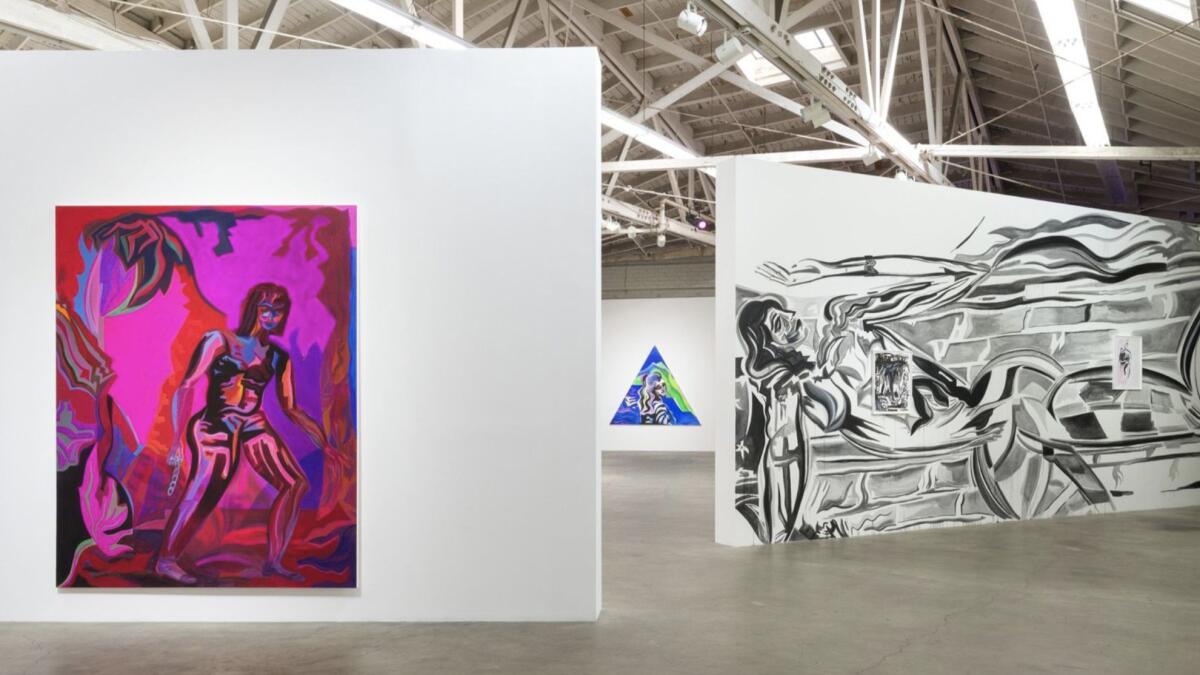
Alejandro Jodorowsky and Pascale Montandon-Jodorowsky, “pascALEjandro,” at Blum & Poe. This is the first major U.S. exhibition of work by the creative pair: he, the renowned film director; she, a long-time painter. The show will brings together their whimsical, often mystical collaborative illustrations, all produced over the last couple of years. Through March 3. 2727 S. La Cienega Blvd., Culver City, blumandpoe.com.
Guadalupe Rosales with Eddie Ruvalcaba, “Endless Nights,” and Beatriz Cortez and Rafa Esparza, “Pasado Mañana,” at Commonwealth & Council. The Koreatown space has a pair of highly intriguing exhibitions. The first, organized by Rosales, brings to life ongoing projects such as @veteranas_and_rucas, which has served as a digital archive of Latino party crews of the ’90s. For the show, she has brought together objects in her collection with those of another assiduous collector, Ruvalcaba, whom she met as part of her project. Together, the pair will create an installation that serves as an evolving altar to these influential youth subcultures. In a separate space, Cortez and Esparza have collaborated on a retro-futuristic installation — part spaceship, part adobe installation, part symbolic agricultural site — that will also feature the work of six invited queer artists. Through March 3. 3006 W. 7th St., Ste. 220, Koreatown, Los Angeles, commonwealthandcouncil.com.
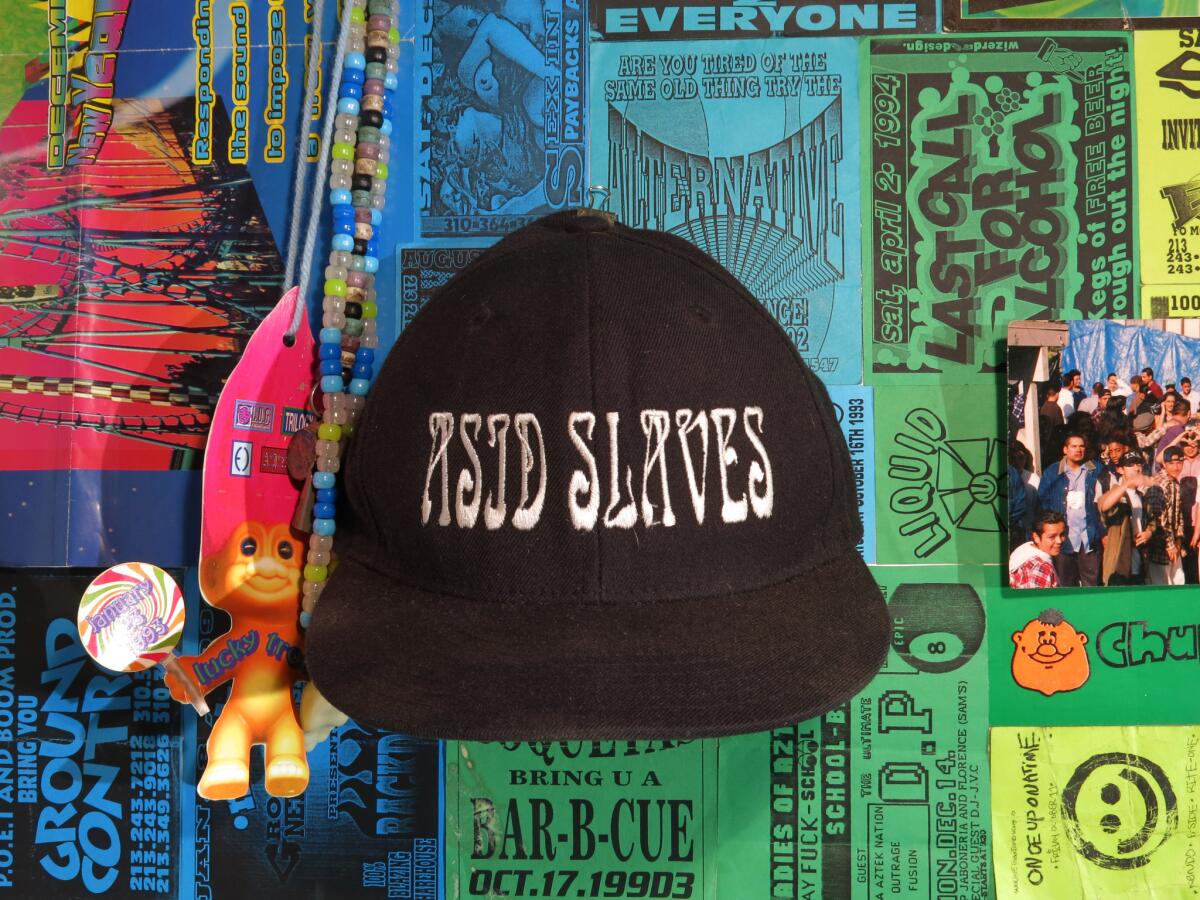
Alyse Emdur, “Skunks and Flowers,” at Odd Ark LA. The Los Angeles artist takes bright nature scenes inspired by the graphic work of Vera Neumann and inserts into their joyous midst roving skunks that serve as a stand-in for femininity’s darker, more mysterious side. Through March 4. 7101 Figueroa St., Unit E, Eagle Rock, oddarkla.com.
“Relational Undercurrents: Contemporary Art of the Caribbean Archipelago,” at the Museum of Latin American Art. Curated by Caribbean art scholar Tatiana Flores, this major survey of 21st century Caribbean art gathers a wide range of work — performance, photography, painting — by more than 80 artists with roots in the region. Organized by theme rather than region, the show looks at subjects common to the diverse populations of the Caribbean: colonialism, race and ethnicity, questions of history and identity, sovereignty, migration and sustainability. A PST: LA/LA must-see. Through March 4. 628 Alamitos Ave., Long Beach, molaa.org.
“Rembrandt: Prints ‘of a Particular Spirit,’” at the Norton Simon Museum. The Dutch Golden Age painter is widely renowned for his deeply human portraits. But he was also a masterful printer. And this exhibition brings together elements of his graphic work from the 1630s, the period in which he became a sought-after portraitist. This includes stirring genre scenes as well as humorous self-portraits — such as an image in which the artist depicts himself as a vagrant. In conjunction with the show, the museum will be displaying Rembrandt’s celebrated “Self Portrait at the Age of 34,” on loan from the National Gallery in London. Through March 5. 411 W. Colorado Blvd., Pasadena, nortonsimon.org.
Edgar Heap of Birds: Do Not Dance for Pay,” at Garis & Hahn. The Oklahoma-based Heap of Birds is an artist who finds meaning in text: creating signage and collaged installations that riff on history, the environment and social phenomena in ways that are pointed yet humorous. This includes an installation that quotes lyrics from American Indian songs (he is Cheyenne and Arapaho) and another that tackles questions of Indian subjugation. Also on view will be abstract paintings that are inspired by environments he visits — as well as sculptures, created in collaboration with a Tongva elder, that evoke indigenous place names around Southern California. Through March 10. 1820 Industrial St., downtown Los Angeles, garisandhahn.com.
Marty Schnapf, “Fissures in the Fold,” and Maria Lynch, “Black Over White,” at Wilding Cran Gallery. A pair of new shows includes an exhibition of new paintings by Schnapf, featuring his surreal and contorted figures inhabiting and slipping into landscapes of color and shape, and Lynch’s new graphite-on-paper drawings, which often serve as starting points for bright paintings. Through March 10. 939 S. Santa Fe Ave., downtown Los Angeles, wildingcran.com.
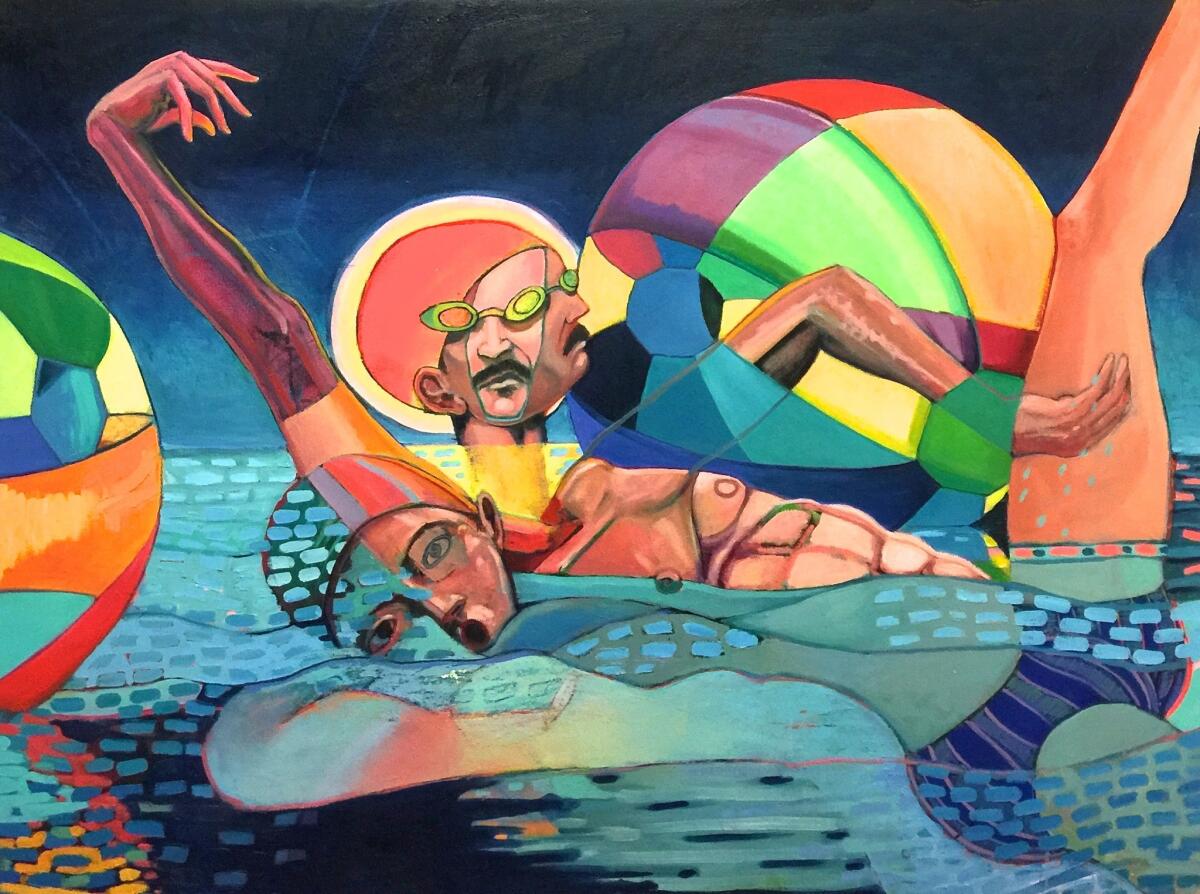
Kota Ezawa, “The Crime of Art (Hollywood Edition),” at Christopher Grimes Gallery. The exhibition centers on a new multi-channel animated film titled “The Crime of Art,” in which Ezawa re-creates scenes from famous art heist films, including “The Thomas Crown Affair” and “How to Steal a Million.” Also on view will be light-box works inspired by stolen works of art, such as Edvard Munch’s “The Scream” and Gustav Klimt’s “Portrait of Adele Bloch-Bauer.” Through March 10. 916 Colorado Ave., Santa Monica, cgrimes.com.
Nathan Vincent, “Let’s Play War,” at Noysky Projects. An immersive installation turns childhood toys — plastic army men — into a series of large, child-sized sculptures made out of crochet. Objects of violence rendered in materials generally reserved for all things domestic. Through March 11. 6727 Hollywood Blvd., Hollywood, noyskyprojects.com.
“¡Murales Rebeldes! L.A. Chicana/o Murals Under Siege,” at La Plaza. A historical exhibition looks at a history of Chicano muralism in Southern California through the works that have been censored and destroyed. This includes documentation of important works by iconic SoCal muralists such as Barbara Carrasco, Yreina D. Cervántez, Willie Herrón III (of Asco fame), Roberto Chavez and the collective known as the East Los Streetscapers (David Botello, Wayne Alaniz Healy and George Yepes). Through March 12. 501 N. Main St., downtown Los Angeles, lapca.org.
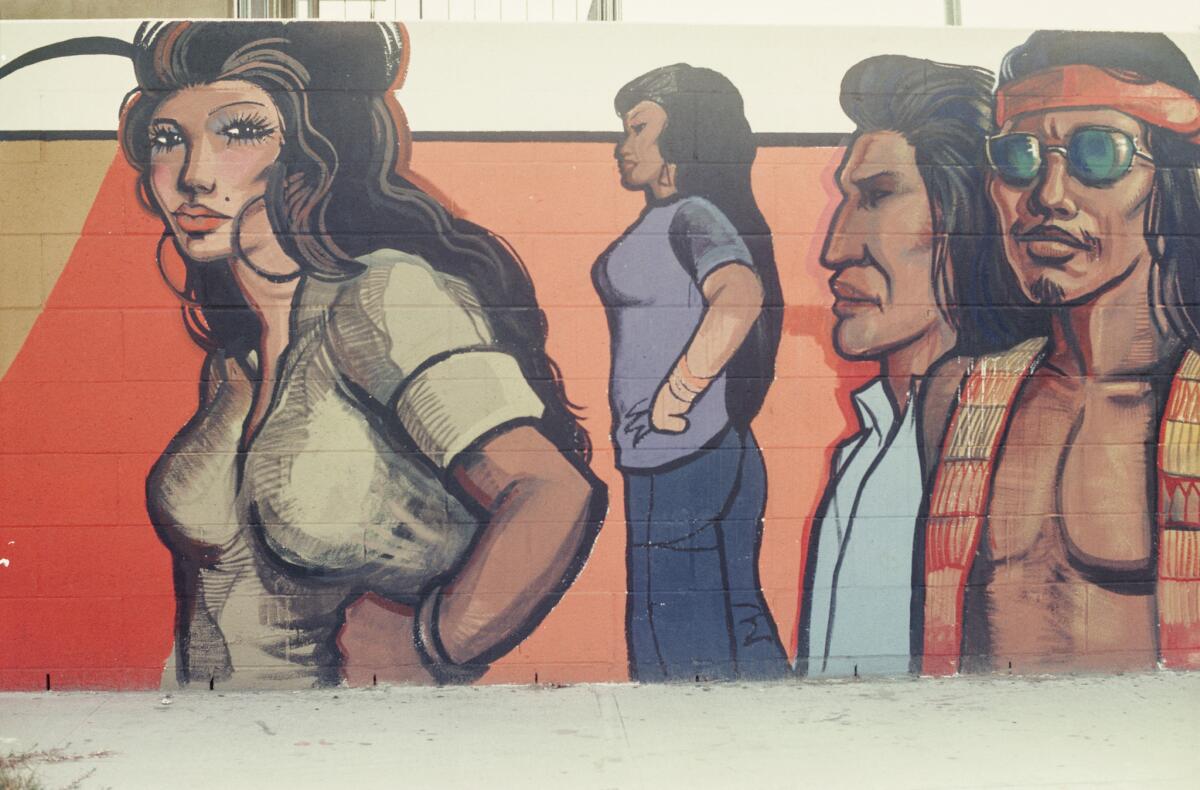
“Praxis Studio,” at the University Art Gallery at Cal State Dominguez Hills. Organized by Leonardo Bravo, of Big City Forum, this group show features work by five Los Angeles artists — EJ Hill, Mario Ybarra Jr., Ana Llorente, Hazel Mandujano and Juan Capistran — who regularly employ community engagement as part of their work. For the show, the artists engaged public school students from South Los Angeles communities as part of residencies funded in part by the California Arts Council. Through March 14. 1000 E. Victoria St., Carson, cah.csudh.edu.
Liza Ryan, “Antarctica,” at Kayne Griffin Corcoran. Ryan has explored Antarctica on foot and by kayak. And in this new series of works, she attempts to convey the continent’s subtleties and its vastness in photographs onto which she traces elements of the landscape with charcoal, ink and graphite — pictures that are taken as much as they are drawn. Through March 17. 1201 S. La Brea Ave., Mid-Wilshire, Los Angeles, kaynegriffincorcoran.com.
Pascual Sisto, “Inside Out,” at Five Car Garage. The New York-based artist and filmmaker takes over this garage gallery with a large-scale four-channel video that also includes elements of audio and synchronized lighting. The images are inspired by the linked nature of web browsing, in which one image or idea leads to the next and down an unending rabbit hole. And they are harvested from a range of sources — including the internet and the artist’s own video archive. The work will evolve over the course of the exhibition, as new elements are added. Through March 17. The gallery is located in a private home in Santa Monica; open Thursdays 12 p.m. to 4 p.m. and Saturdays 2 p.m. to 4 p.m., email for directions, emmagrayhq.com.
John Duncan at Nicodim. When Duncan lived in L.A. in the ’70s, he was known for staging actions that were (to put it delicately) abject and raw, such as shooting at a pair of friends with a pistol loaded with blanks. Another infamous action involved a cadaver and a vasectomy. The show will include an installation titled “Rage Room” that, with its bloody walls and smashed furniture, serves as tribute to, well, rage. Through March 17. 571 S. Anderson St., Boyle Heights, Los Angeles, nicodimgallery.com.
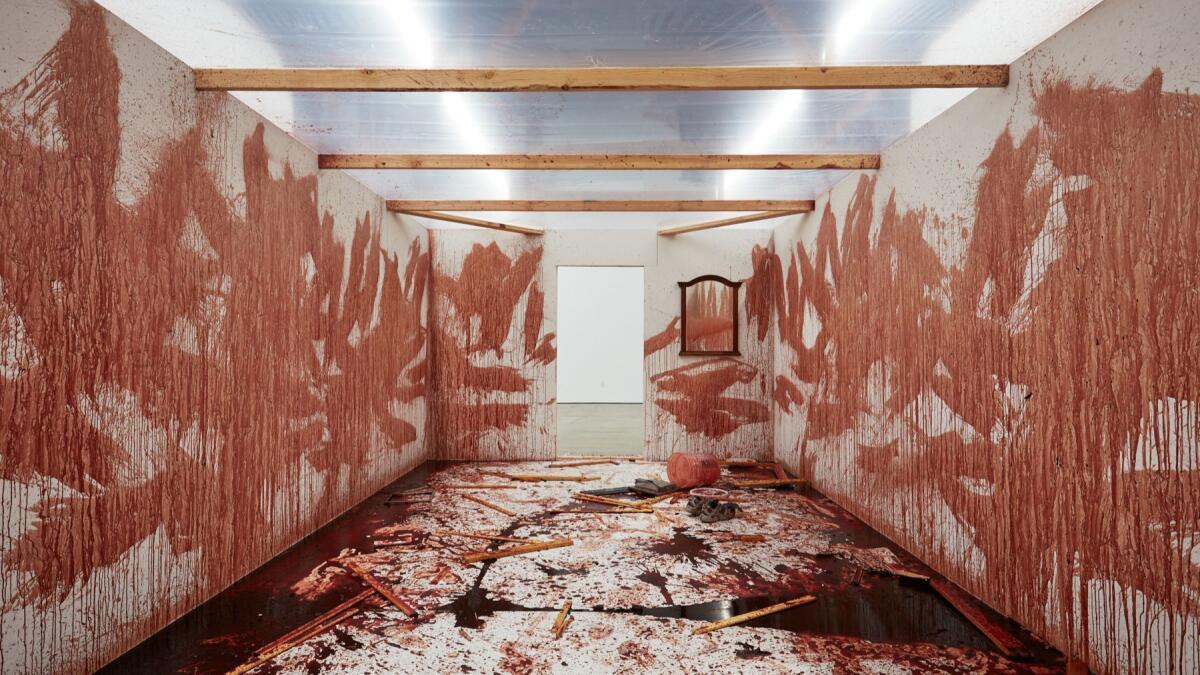
“New Threads: Perspectives in Contemporary Fiber Art,” at the Laband Art Gallery. A contemporary textiles show features work by more than 15 artists — from the region and the world — all reflecting on issues of technology, the body and the reframing of traditional forms in contemporary ways. Through March 17. Loyola Marymount University, 1 LMU Dr., cfa.lmu.edu/labandgallery.
“Painted in Mexico, 1700-1790: Pinxit Mexici,” at the Los Angeles County Museum of Art. This groundbreaking exhibition gathers more than 100 paintings created in Mexico over the course of the 18th century — many on view for the first time. The exhibition, organized by LACMA and the Fomento Cultural Banamex in Mexico City, and part of PST: LA/LA, looks at the paths that Mexican painting was taking in the third century after colonization — influenced by transatlantic trade, but also developing a voice of its own. The period saw a rise in the creation of mural-size works to decorate churches, as well as a boon in the region’s singular casta paintings, which documented the racial types of the booming colony. The works range from the pastoral to the wondrously bizarre. Don’t miss the puzzling allegorical canvas that shows the continent of America in the company of ancient rulers Moctezuma and Atahualpa. Through March 18. 5905 Wilshire Blvd., Mid-Wilshire, Los Angeles, lacma.org.
“Soul Recordings,” at Luis De Jesus Los Angeles. A group exhibition featuring works by artists such as Lisa C. Soto, Deborah Roberts, Caitlin Cherry and Lex Brown shines a spotlight on our state of political unease. This includes work that examines neocolonial architecture, painting that toys with the nature of stereotype and textile work that takes on issues of gender. Accompanying the exhibition will be an essay written by independent curator Jill Moniz, who organized the very compelling show of sculpture by African American female artists at the Landing last year. Through March 24. 2685 S. La Cienega Blvd., Culver City, luisdejesus.com.
Esmaa Mohamoud, “THREE-PEAT,” at Ltd. Los Angeles. The African Canadian artist employs a variety of media to look at the intersection of race, gender and sports. This includes creating an installation out 60 concrete basketballs and photographs of men wearing ball gowns inspired by team jerseys. It continues a theme she recently touched on at an exhibition at the Art Gallery of Ontario. Through March 24. 1119 S. La Brea Ave., Mid-Wilshire, Los Angeles, ltdlosangeles.com.

Vija Celmins,” at Matthew Marks Gallery. This show gathers more than 20 works produced over the last four years by the artist, as well as the first exhibition of Celmin’s new work in L.A. in more than 40 years. This includes a large painting of a night sky in reverse — featuring dark stars on a light sky — and a close-up painting of cracks on a plate that becomes a pattern of lines and color. Expect work that invites introspection. Through March 31. 1062 N. Orange Grove Ave., West Hollywood, matthewmarks.com.
Mondongo, “What are we gonna say after HELLO?” at Track 16 Gallery. The Argentine collective, which recently had work on view in two Pacific Standard Time exhibitions, is known for creating wild vitrines and dioramas out of carefully assembled bits of detritus or Plasticine. These sculptural pieces — part painting, part three-dimensional object — often evoke dystopic fairy tales, with an acerbic eye toward social, political and economic issues. Through March 31. 1206 Maple Ave., No. 1005, downtown Los Angeles, track16.com.
“Found in Translation: Design in California and Mexico,” at the Los Angeles County Museum of Art. A groundbreaking design exhibition looks at the points of connection in design — architectural, fashion, graphic and other — between California and Mexico between 1915 and 1985. It’s a thorough examination of how designers in the two locales combined local materials with an interest in pre-Columbian and colonial design, as well as folk and craft traditions, to create singular approaches to Modernism that also overlapped in countless ways. The exhibition includes a diverse range of objects, including dresses, political posters, architectural drawings, furnishings and a show-stopping late 19th century piano carved in a pre-Columbian style. Wowza! Through April 1. 5905 Wilshire Blvd., Mid-Wilshire, Los Angeles, lacma.org.
“Patrick Martinez: America is for Dreamers,” at the Vincent Price Art Museum. This is the artist’s first solo museum exhibition in Los Angeles, a figure whose work examines the city’s landscape (such as stucco walls, commercial neon, street signage) as much as the social forces that shape it (inequity and police violence). The show’s title toys with notions of the American dream, as well as the uncertain status of recipients of Deferred Action for Childhood Arrivals (known as DACA), the federal program that allows illegal immigrants brought to the U.S. as children to remain in the country. Through April 7. East Los Angeles College, 1301 Cesar Chavez Ave., Monterey Park, vincentpriceartmuseum.org.
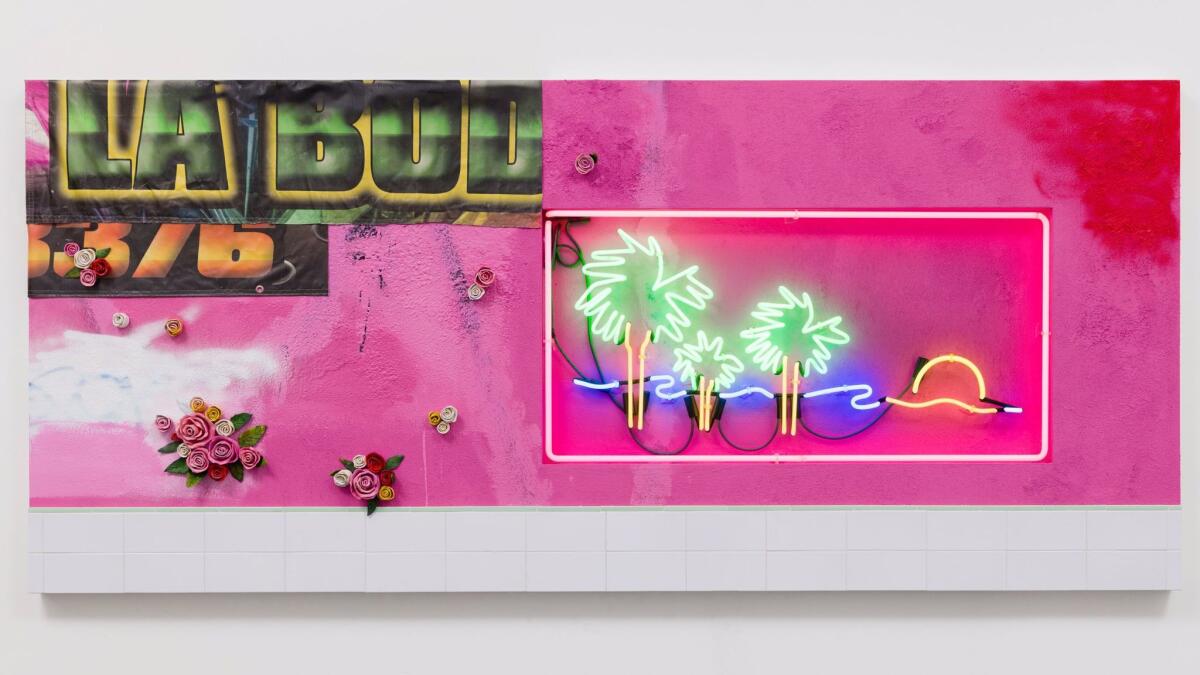
Skip Arnold, “Truffle Hunt,” at the Institute of Contemporary Art Los Angeles. A video installation by Los Angeles-based Skip Arnold is centered on a film that followed Arnold, along with artists Jason Rhoades and Hans Weigand, on a journey to Europe in search of truffles. The show includes maps and other ephemera from their journey — as well as truffles that were smuggled back to L.A. by the artists. Through April 8. 1717 E. 7th St., downtown Los Angeles, theicala.org.
“Outcasts: Prejudice and Persecution in the Medieval World,” at the Getty Museum. An exhibition of medieval manuscripts looks at how the illustrations featured on their pages often revealed a range of era prejudices: against women, Jews, Muslims, blacks, homosexuals, the poor and the ill, who were often depicted in menacing or cartoonish ways. Also included in the show are examples in which images were censored in the name of politics or morality. This one looks fascinating. Through April 8. 1200 Getty Center Dr., Brentwood, Los Angeles, getty.edu.
“Liquid Love,” at Gas. Parked outside of the Pit gallery in Glendale will be this ambulatory gallery space featuring a group show that explores desire, love and affection — and the ways in which technology intersects with these needs. Artists included in the show will include Cara Benedetto, Kathy Cho and Angelo Washko. Through April 14. 918 Ruberta Ave., Glendale, gas.gallery.
Senga Nengudi, “Improvisational Gestures,” at the Fisher Museum of Art. An artist known as much for installation (wild webs of pantyhose that seem to strangle and pull) as she is for dance-inspired performances, Nengudi is the subject of a solo show at the museum that provides a comprehensive overview of her work — including formative years in Los Angeles. Through April 14. USC, 823 Exposition Blvd., Exposition Park, Los Angeles, fisher.usc.edu.
“Axé Bahia: The Power of Art in an Afro-Brazilian Metropolis,” at the Fowler Museum. Brazilian art has been well-represented throughout the Pacific Standard Time exhibitions around the region. This show looks specifically at what has been happening artistically in Bahia since the 1940s, the city that represents the heart of Afro-Brazilian culture. This includes works by key Modernists, including Mário Cravo Neto and Rubem Valentim, as well as contemporary figures such as as Caetano Dias and Ayrson Heráclito — all represented in more than 100 works of sculpture, painting, photography, video and installation. Through April 15. UCLA, 308 Charles E. Young Drive North, Westwood, Los Angeles, fowler.ucla.edu.
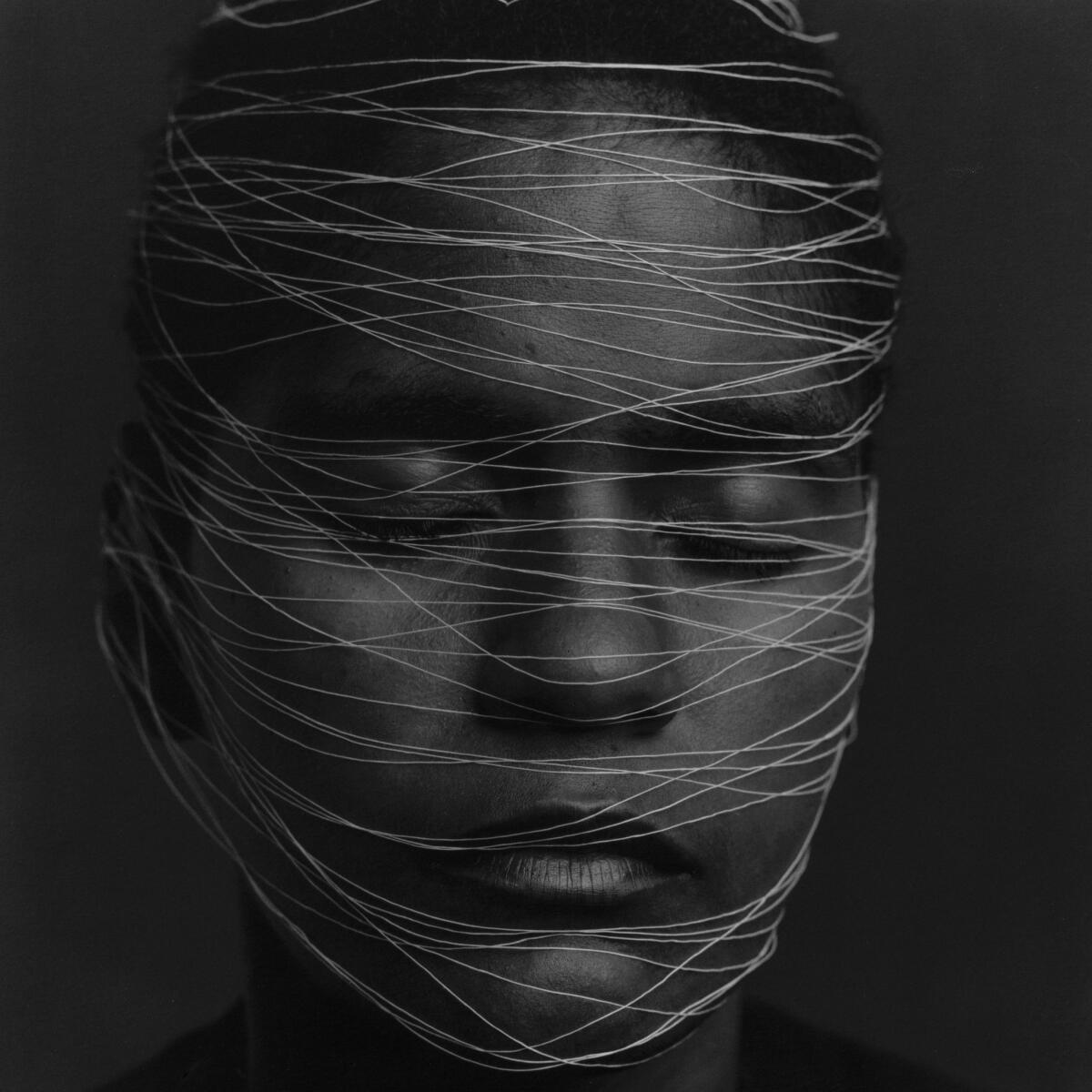
Robert Irwin, “Site Determined,” at the University Art Museum. In 1975, Irwin installed a sculptural piece called “Window Wall” into a building on the Cal State Long Beach campus. The work, a frame of sorts, was embedded into the school’s architecture, and served as a space from which to contemplate the environment of the campus. That piece was a turning point in his career — and serves as a departure point for this exhibition, which examines four decades of the artist’s outdoor projects. Through April 15. Cal State Long Beach, 1250 Bellflower Blvd., Long Beach, csulb.edu/university-art-museum.
“Harald Szeeman Grandfather: A Pioneer Like Us,” at the Institute of Contemporary Art Los Angeles. In the 1970s, celebrated curator Harald Szeeman organized the objects collected and created by his grandfather — a noted hairdresser — into an installation that he staged in his home. The show at the ICA LA will feature a recreation of Szeeman’s show and materials from the Getty Research Institute, which holds the curator’s archive. Through April 22. 1717 E. Seventh St., downtown Los Angeles, theicala.org.
“Cold War Spaces,” “The Russians” and “Vessel of Change” at the Wende Museum. The museum, an underrated Los Angeles gem preserving the art and history of the Cold War, is celebrating a move to new digs at the National Guard Armory in Culver City. The grand reopening is marked by the debut of three new exhibitions: “Cold War Spaces” looks at the design of public and private environments, borders and the objects sent into outer space by the U.S. and the former U.S.S.R. “The Russians” is based on a 1970s photo project by Nathaniel Farb that documented a diverse array of ordinary Russians, while “Vessel of Change” is a playful video piece by Bill Ferehawk and David Hartwell that reinterprets the historic Malta Summit between George H.W. Bush and Mikhail Gorbachev in 1989. Through April 29. 10808 Culver Blvd. Culver City, wendemuseum.org.
“Hammer Projects: Sam Falls” at the Hammer Museum. For the Hammer’s latest lobby project, the L.A.-based artist traveled to all 19 National Forests in California. In these journeys, he gathered samples of the state’s vegetation, including Ponderosa pine trees and California buckwheat. He then dusted the samples with pigment, employing them as stencils of sorts, to create silhouettes of important state flora. Through April 29. 10899 Wilshire Blvd., Westwood, Los Angeles, hammer.ucla.edu.
John Ford, Samuel Fuller, George Stevens, “Filming the Camps: From Hollywood to Nuremberg,” at the Los Angeles Museum of the Holocaust. Organized by the Mémorial de la Shoah in Paris, this exhibition looks at the vital work done by three key American filmmakers during World War II. Ford, Fuller and Stevens, in the employ of the U.S. Armed Forces and the Secret Services, filmed key aspects of the war — including the liberation of the Nazi concentration camps. The show includes film footage, personal letters, important ephemera and other rare objects and reflects on the way in which playing witness to Nazi atrocities shaped the worldview of these important directors. There could not be a more timely moment for this exhibition. Through April 30. 100 S. Grove Dr., Fairfax District, Los Angeles, lamoth.org.
“Harald Szeemann: Museum of Obsessions,” at the Getty Research Institute. This exhibition explores the life, work and obsessions of the esteemed Swiss curator who helped redefine the profession. The show examines his early exhibitions and the ways in which he collaborated with avant-garde artists, the ways in which he turned curation into a global job, as well as his personal collections and obsessions. Through May 6. 1200 Getty Center Drive, Brentwood, getty.edu.
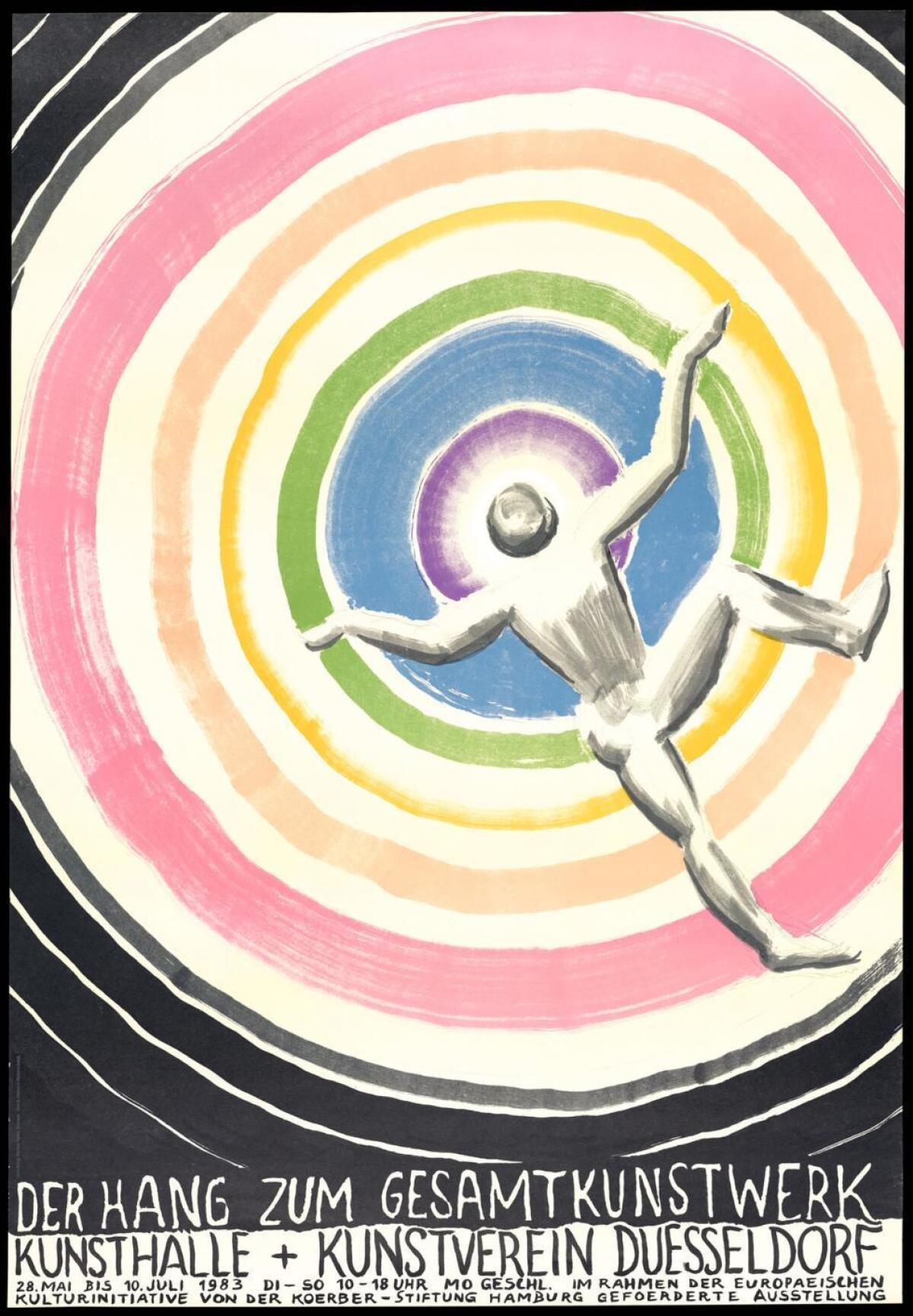
“Stories of Almost Everyone,” at the Hammer Museum. In the age of hyper-conceptual art, the story about the art often resides less in the object than in the stories that are told about it: the curator talks and wall text descriptions. This exhibition examines this very phenomenon — the curious oral history often generated by conceptual work and how those histories are passed on. Should be seriously brainy. Through May 6. 10899 Wilshire Blvd., Westwood, Los Angeles, hammer.ucla.edu.
“Melting Point: Movements in Contemporary Clay,” at the Craft & Folk Art Museum. This is the museum’s first biennial devoted to clay, featuring work by almost two dozen artists who are working with the material in innovative and unusual ways. Through May 6. Artist-in-residence Wayne Perry will be on-site making work on Sunday at 1 p.m. and again on March 25, also at 1 p.m. 5814 Wilshire Blvd., Mid-Wilshire, cafam.org.
“Robert Polidori: 20 Photographs of the Getty Museum, 1997” at the Getty Museum. The Getty has turned 20 (it can almost drink!), and to mark the occasion the museum is showing a portfolio of works created by Polidori prior to the museum’s opening in ’97. The photos, on view for the first time, caught the galleries in transition: art wrapped in crates, sculptures off pedestals, bits of packing material in decorative rooms. Through May 6. 1200 Getty Center Drive, Brentwood, Los Angeles, getty.edu.
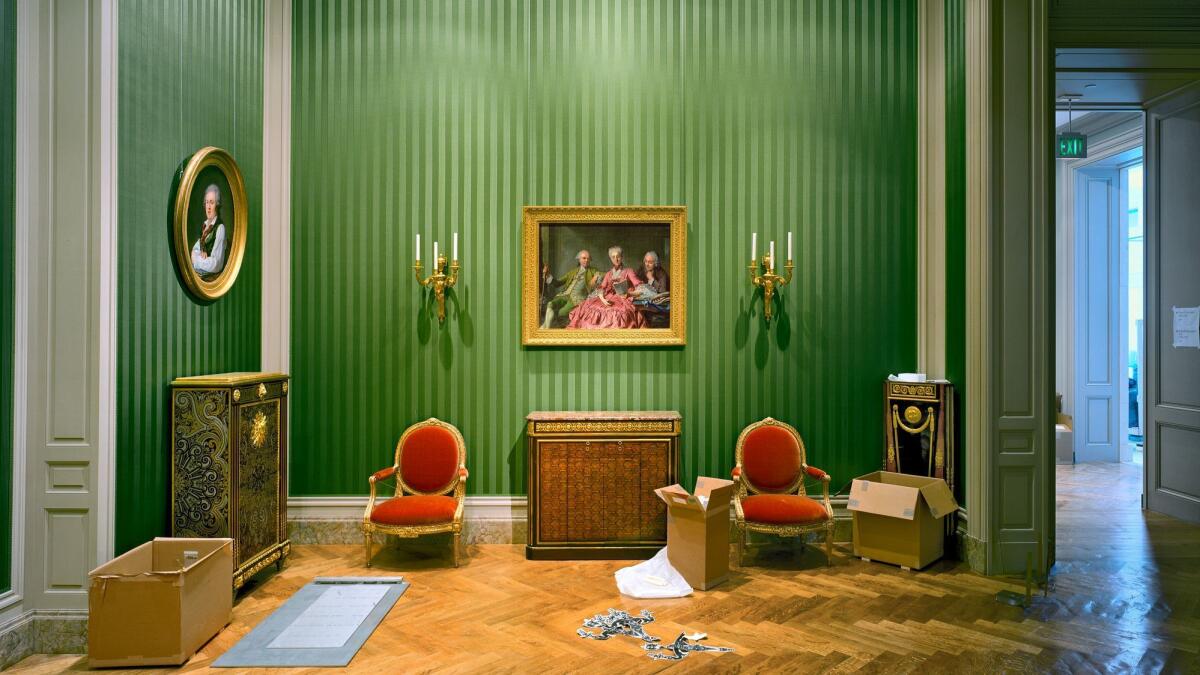
Adrián Villar Rojas, “The Theater of Disappearance,” at the Museum of Contemporary Art. The Argentine-born artist, known for installations that transform spaces — and often play on themes of the apocalyptic — is taking over MOCA’s Little Tokyo space with an installation that employs the architecture and technologies of Hollywood special effects to create an environment that responds to a “post-human world dominated by technology.” Through May 13. Geffen Contemporary, 152 N. Central Ave., downtown Los Angeles, moca.org.
“Muse: Mickalene Thomas,” and “tête-à-tête,” at Pomona College Museum of Art. This show explores two aspects of Thomas’ work: the muses who have inspired her work and the artists with whom she finds kinship. The first part gathers the artist’s photography of herself, her mother, her friends and lovers — images that inspire and serve as the basis of her work. The latter part features an installation curated by Thomas that features work by artists she finds inspiring, including figures such as Deana Lawson, Zanele Muholi and LaToya Ruby Frazier. Through May 13. 330 N. College Ave., Claremont, pomona.edu/museum.
“Unspeakable: Atlas, Kruger, Walker,” at the Hammer Museum. The museum has installed videos by three artists — Charles Atlas, Barbara Kruger and Kara Walker — known for the ways in which they wield art as social critique. This includes works that ruminate on the nature of life, generosity, the body and violence. Through May 13. 10899 Wilshire Blvd., Westwood, Los Angeles, hammer.ucla.edu.
Jasper Johns, “ ‘Something Resembling Truth,’ ” at the Broad museum. An exhibition created in collaboration with the Royal Academy in London will feature more than 120 paintings, sculptures, prints and drawings by the celebrated 20th century artist associated with the early days of the Pop movement. The show traces his six-decade career through a series of themed installations that examine the stages of his career, as well as the innovative ways in which he employed materials such as encaustic, collage and other media. The show includes many works that have never been seen before in Los Angeles — a real treat. Get those tickets! Through May 13. 221 S. Grand Ave., downtown Los Angeles, thebroad.org.
Geta Brătescu, “The Leaps of Aesop,” at Hauser & Wirth. The 92-year-old Romanian conceptualist’s first show in Los Angeles consists of more than 50 works drawn from throughout different periods of her career — all inspired by the Greek fabulist Aesop. The artist regards Aesop as a mischievous figure, a symbol of “everything that stood against totalitarianism,” and one who parallels the subversive characters in Romanian folk tales. In her own work, she uses play and other inventive approaches to material to convey these and other ideas. Through May 20. 901 E. 3rd St., downtown Los Angeles, hauserwirthlosangeles.com.
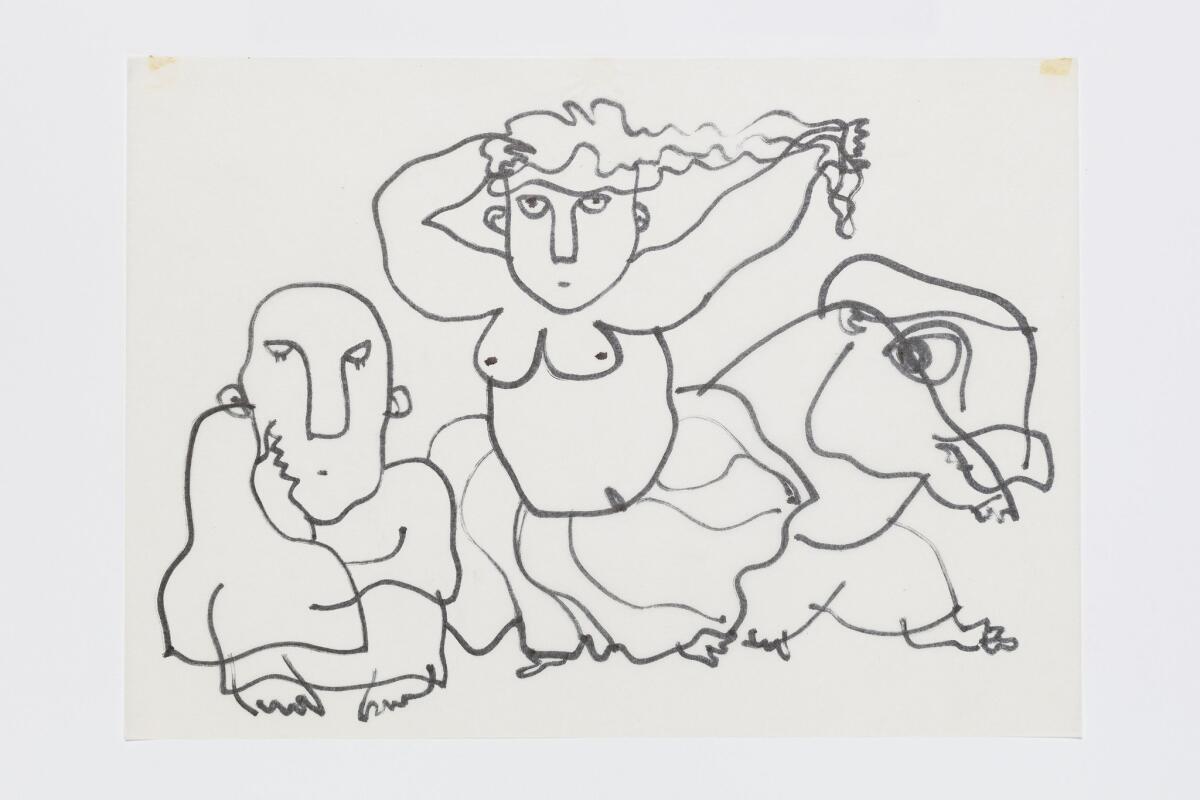
Mark Bradford, “New Works,” at Hauser & Wirth. The gallery is showing a suite of new works by the Los Angeles painter, who continues his process of creating abstraction through a process of collaging, tearing, painting and layering. The new works, which employ comic books in their fabrication, pack a visceral punch. Through May 20. 901 E. 3rd St., downtown Los Angeles. hauserwirthlosangeles.com.
“Testament of the Spirit: Paintings by Eduardo Carrillo,” at the Pasadena Museum of California Art. A solo exhibition devoted to the Los Angeles painter and educator examines his legacy and work. The show includes the exhibition of a celebrated mural, “Chicano History,” which Carrillo painted with Sergio Hernandez, Ramses Noriega and Saul Solache, and which is on view for the first time since 1991. The museum has also unveiled two other exhibitions: “The Feminine Sublime,” a group show that takes ideas of the sublime, generally depicted from a male point of view, and gives it a decidedly feminine twist, as well as an installation by Ana Serrano, who is creating an immersive “garden” out of simple art materials such as cardboard, paper and paint. Through June 3. 490 E. Union St., Pasadena, pmcaonline.org.
“In Conversation: Alma Allen & J.B. Blunk,” at the Palm Springs Art Museum. This exhibition puts together the work of two key artists from two generations working with natural materials such as stone, wood and metal. J.B. Blunk, who passed away in 2002, began making work in the ’60s inspired by organic and anthropomorphic forms. Allen, a contemporary artist, quite similarly works in metal and wood and is inspired by nature’s shapes and textures. Both have created functional objects (such as elements of their homes) as well as sculptures that are experimental and abstract. Through June 4. 300 S. Palm Canyon Dr., Palm Springs, psmuseum.org.
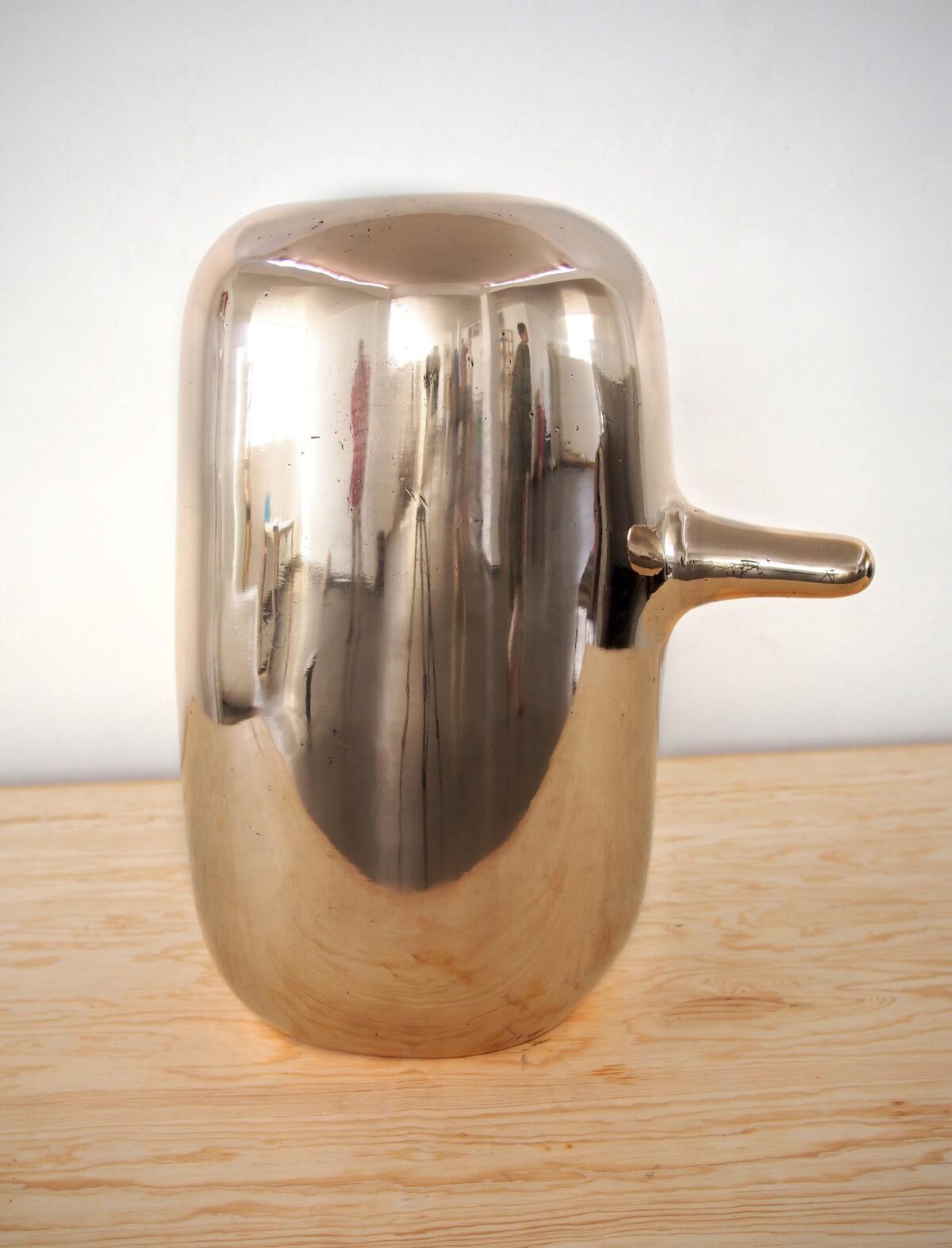
“Winds from Fusang: Mexico and China in the Twentieth Century,” at the USC Pacific Asia Museum. This is the first major exhibition to look at a key trans-Pacific cross-pollination: the influence of Mexican art on the development of art in China in the 20th century. This includes an examination of the period in the 1930s that Mexican artist Miguel Covarrubias spent in Shanghai, and a look at a subsequent era, from the 1950s to the ’70s, when works by key Mexican artists were presented in China. The show, part of PST: LA/LA, is a grand reopening for the museum following a seismic retrofit. Through June 10. 46 N. Los Robles Ave., Pasadena, pacificasiamuseum.usc.edu.
Meleko Mokgosi, “Bread, Butter, and Power,” at the Fowler Museum. Mokgosi first drew wide attention in Los Angeles when he won the $100,000 inaugural Mohn Prize at the Hammer Museum’s “Made in L.A.” biennial in 2012. Now he’s back with a large-scale painting exhibition at the Fowler — a 20-panel installation that looks at how democratic concepts infuse aspects of daily life, down to love and relationships. Through July 1. 308 Charles E. Young Drive N., Westwood, Los Angeles, fowler.ucla.edu.
“Gary Simmons: Fade to Black,” at the California African American Museum. In a lobby installation — one that takes full advantage of its size and scale — Simmons pays tribute to forgotten African American actors and films. On a black background, the L.A. artist features the titles and names of films and individuals important to the early days of Hollywood history, but forgotten over time. Through July 2018. 600 State Drive, Exposition Park, Los Angeles, caamuseum.org.
Leopoldo Peña, “Pelotas Oaxaqueñas/Oaxacan Ball Games,” at the Fowler Museum. For five years beginning in 2011, the L.A.-based painter has documented the traditional games played by California’s Oaxacan immigrant community. The games includes the centuries-old pelota mixteca (Mixtec-style ball) and variant called pelota de esponja (sponge ball), both played with decorated mitts that combine indigenous design with contemporary logos. The games, which often take place in empty lots around the San Fernando Valley, are fast-paced affairs that serve as important social gatherings. Through July 15. 308 Charles E. Young Dr. N., Westwood, Los Angeles, fowler.ucla.edu.
Harry Gamboa Jr, “Chicano Male Unbonded,” at the Autry Museum of the American West. For years, Gamboa has photographed Chicano men — often figures with whom he has a personal relationship — at night in the dark from a low angle, giving his figures an imposing authority. This exhibition gathers more than 80 of those images into a single-room installation: scholars, artists, musicians, thinkers, photographers and even the artist’s dad, a printer — collectively calling into question the general public’s (not to mention our president’s) stereotyped view of Mexican-American men. Through Aug. 5. 4700 Western Heritage Way, Griffith Park, Los Angeles, theautry.org.
Adler Guerrier, “Conditions and Forms for blck Longevity,” at California African American Museum. The Haitian artist is the subject of a solo exhibition at the museum that explores the nature of domestic gardens and other outdoor spaces as mini-utopias. This project looks at spaces in Miami and L.A. where black life takes place in sheltered, protected ways. Through Aug. 26. 600 State Dr., Exposition Park, Los Angeles, caamuseum.org.
“La Raza,” at the Autry Museum of the American West. In its day, the civil rights publication La Raza, which was based in Lincoln Heights, served as a bible for the Chicano movement, covering protest, policy and everyday life for the Mexican American communities of Los Angeles. Over the years, the paper amassed an archive of 25,000 images, recently digitized by the Chicano Studies Research Center. Many are now on view as part of this PST: LA/LA show at the Autry — and in a time of political strife surrounding the issues of civil rights, this exhibition couldn’t be more timely. Through Feb. 10, 2019. 4700 Western Heritage Way, Griffith Park, Los Angeles, theautry.org.
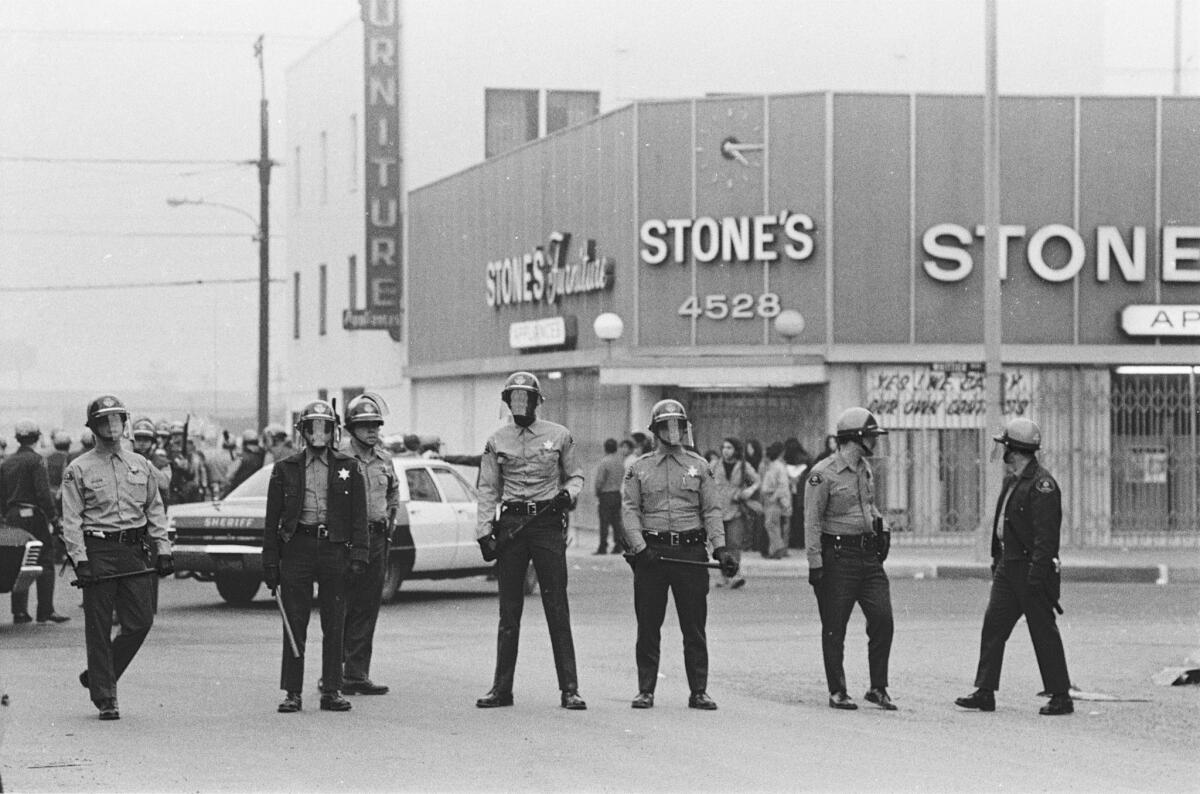
“Artists of Color,” at the Underground Museum. As part of its ongoing partnership with the Museum of Contemporary Art, the Arlington Heights arts space has put together an exhibition that focuses on color — on its aesthetics, as well as the roles color can play as a symbol, affecting the way it’s perceived both socially and politically. The show includes works by an array of artists, including Ellsworth Kelly, Dan Flavin, Lita Albuquerque, EJ Hill, Felix Gonzalez-Torres, Josef Albers, Carmen Herrera and Noah Davis (the late founder of the Underground Museum). It’s a striking look at color seen anew. On long-term view; no closing date set. 3508 W. Washington Blvd., Arlington Heights, theunderground-museum.org.
“L.A. Communities Through the Eyes of Artists,” in the Passageway Gallery at Union Station. For 15 years, L.A.’s principal train station has been showcasing work that reveals the city through the eyes of its artists. This year, it is showing a series of newly commissioned pieces — including Shizu Saldamando’s depiction of Little Tokyo, Sam Pace on Leimert Park and Artemio Rodriguez on East L.A. On long-term view; no closing date set. Union Station, 800 N. Alameda St., downtown Los Angeles, metro.net.
Alejandro G. Iñárritu, “Carne y Arena,” at LACMA. The gripping new virtual reality experience by the Academy Award-winning director places the participant in the shoes of migrants making the arduous trek through the Sonoran desert to reach the United States. This may sound like the trivialization of what can be a fatal journey, but it is not. Iñárritu has considered all of the elements that surround his virtual reality video to humanize the story of immigration on the U.S.-Mexico border. I wrote about my experience of the piece in June. It’s not cheap (a $30 special admission, in addition to regular museum fees) but it’s worth every penny. On long-term view; no closing date set. 5905 Wilshire Blvd., Mid-Wilshire, Los Angeles, lacma.org.
Daniel Hawkins, “Desert Lighthouse.” The Los Angeles-based artist is obsessed with producing works that toy with ideas of grandiosity, failure and gestures that border on the Sisyphean. (One of his goals as an artist is to ultimately build a scale replica of Hoover Dam.) Now Hawkins has installed a 50-foot tall, fully functioning lighthouse in the Mojave Desert in the vicinity of Barstow. The piece even features a light to guide travelers through this rugged landscape. Directions and coordinates can be found on the website. On long-term view, Hinkley, Calif., desertlighthouse.org.
Sign up for our weekly Essential Arts & Culture newsletter »
Twitter: @cmonstah
The biggest entertainment stories
Get our big stories about Hollywood, film, television, music, arts, culture and more right in your inbox as soon as they publish.
You may occasionally receive promotional content from the Los Angeles Times.




